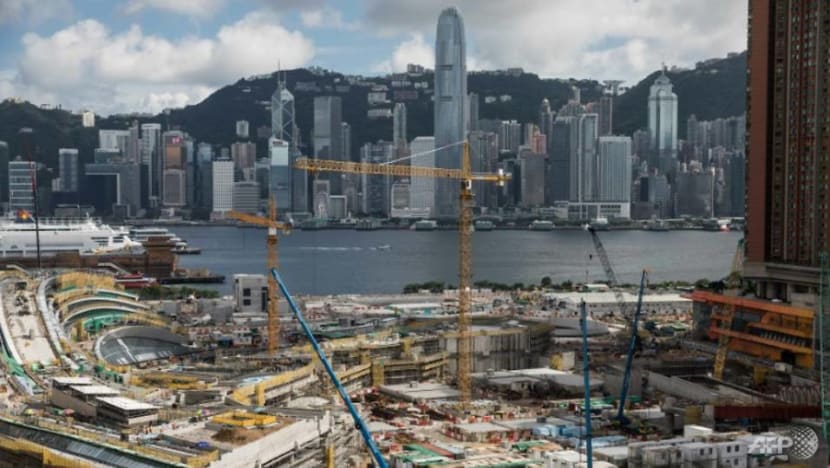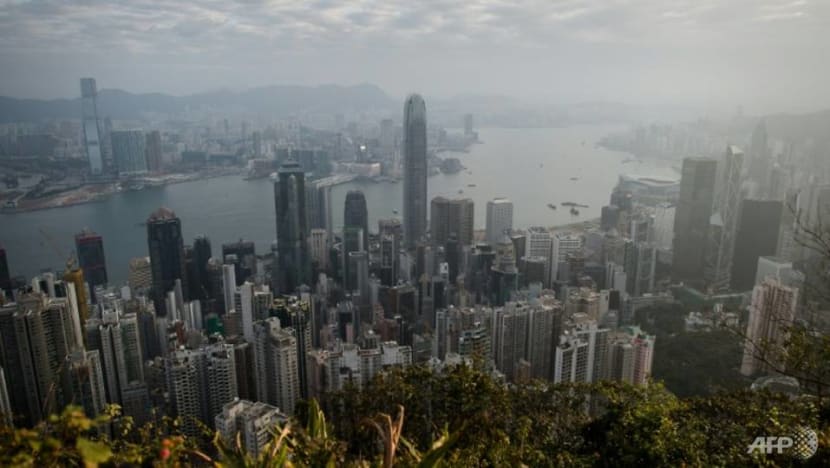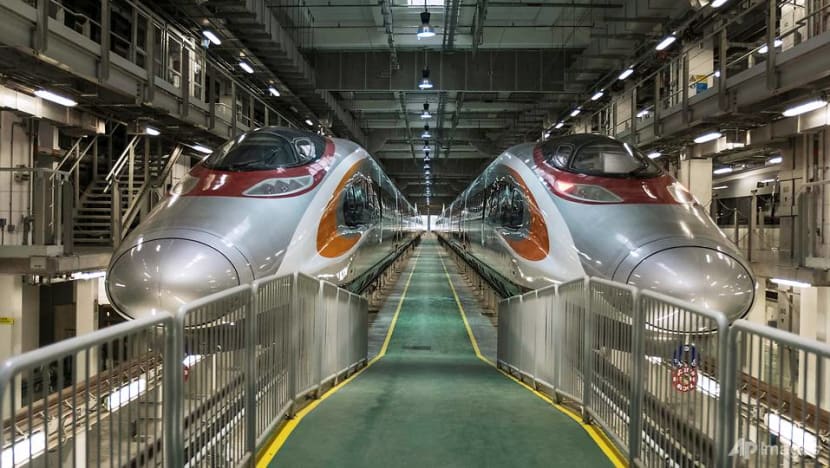commentary Commentary
Commentary: The magnificent new global city cluster in China’s Pearl River Delta
A new economic centre of gravity is emerging in China, as developments in the Pearl River Delta spearheads the country’s economic transition, says HSBC’s Greater China CEO.

The new rail project linking Hong Kong to the southern Chinese city of Guangzhou is one of a number of cross-border infrastructure projects, including a bridge to the mainland and the neighbouring casino enclave Macau. (Photo: AFP/Dale De La Rey)
HONG KONG: China is forging ahead with a plan to create a globally competitive, world-class metropolis in the south of the country, known as the Guangdong-Hong Kong-Macau Greater Bay Area.
It is bringing innovation, finance and trade to the forefront and is emerging as a new leader in globalisation.
Guangdong has long been the frontrunner in China’s reform and opening-up policy since the late 1970s. The province is yet again leading this economic transition, shifting from being the world’s factory floor to a highly dynamic hub for services and innovation.
One of the key pieces of Guangdong’s success story is its geographical proximity to Hong Kong – and the symbiosis between the two sides has been largely market driven.
To further evolve and deepen the economic integration of Guangdong, Hong Kong and Macau and elevate the region’s standing in China’s economic development and opening-up, China has drawn up a plan for the development of a city cluster known as the Pearl River Delta Greater Bay Area.
This landmark initiative is based on natural geographical conditions, intended to link nine cities in Guangdong’s Pearl River Delta – Guangzhou, Shenzhen, Zhuhai, Foshan, Zhongshan, Dongguan, Huizhou, Jiangmen and Zhaoqing – together with the two Special Administrative Regions of Hong Kong and Macau to establish a globally competitive economic cluster.
Over the past few decades, the Greater Bay Area’s cities have each developed their own unique advantages and economic structures. The plan’s ambition is combining Hong Kong, Macau and Guangdong’s complementary advantages in areas such as well-established manufacturing supply chains, innovation capacity, financial services, logistics and sophisticated consumer markets.
The goal is to build a new economic powerhouse – one that is not only at the forefront of China’s economic development, but comparable to leading global bay areas such as Tokyo, San Francisco or New York.

This vision is not unrealistic in my opinion. Together, the eleven cities in the Greater Bay Area can be as prosperous as a standalone country in terms of population, size of its economy and its resources.
GREAT POTENTIAL AND SYNERGIES
The Greater Bay Area has a combined population of 67.95 million, which is greater than the Tokyo Metropolitan Area – the world’s largest city cluster with a population of 44 million. It covers approximately 56,000 square kilometres comparable to that of the New York Bay Area.
As one of China’s fastest-growing regions, the Guangdong-Hong Kong-Macau Greater Bay Area had a combined GDP of US$1.4 trillion in 2016.
By 2030, the region’s GDP is expected to reach US$4.6 trillion, surpassing Tokyo, New York and San Francisco bay areas to become the world’s largest bay in terms of the size of its economy.
The Greater Bay Area is not only economically enormous, but also has a large number and diversified industries with distinct competitiveness, globally and domestically.
If you look at successful bay areas around the world, there are a number of factors that are consistent among them. All contain a thriving international financial centre, developed service industries, a solid transport network, multiple top-ranked universities as well as a technology innovation hub.
Good examples are highly ranked cities that include San Francisco Bay Area for innovation and high-tech, and New York for financial services.
Just as Silicon Valley lies at the heart of the San Francisco Bay Area, Shenzhen has a large manufacturing sector and has become a hothouse of innovation for China. The city is home to Huawei and Tencent, two of China’s most valuable and inventive multinationals. Foreign tech giants such as Apple are also building research and development centres there.
Hong Kong is the perfect complement to Shenzhen’s innovative environment. It will continue to play its role as a financial centre and serve as a launch pad for Chinese companies going global.

Together with Shenzhen and its stock exchange – one of two in mainland China – the two cities are similar to New York with their thriving financial centres and stock exchanges. For example, Chinese web giant Tencent is based in Shenzhen but listed on the Hong Kong Stock Exchange.
Meanwhile, Guangzhou leads the way as an advanced manufacturing and modern services centre.
And Macau, together with its neighbour, Hengqin in Zhuhai, aspire to form an international leisure capital.
Combining the strengths of these core cities together with rest of the Pearl River Delta cities’ vast resources, spaces and cheaper labour, the Greater Bay Area will see substantial improvement in its strength in global cooperation and competition, and ascend to become an important global city cluster for innovation, finance, shipping and trade.
INFLUENCE BEYOND CHINA
As the Greater Bay Area develops, its influence will extend well beyond its geographical boundaries to play a key role in supporting the development of China’s Belt and Road Initiative. It will serve as a key link connecting countries along the Silk Road Economic Belt (Central Asia to Europe) and the Maritime Silk Road (South Asia, Oceania to Africa and the Middle East) together.
A comprehensive transport network is vital. The Tokyo Bay Aqua-Line bridge-tunnel and the San Francisco-Oakland Bay Bridge, along with the Golden Gate Bridge, are just a few examples of iconic bay district infrastructure.
The Greater Bay Area has improved transport infrastructure significantly in recent years which has laid the foundation for regional integration. The Guangzhou-Shenzhen-Hong Kong express rail link is expected to open to the public in the third quarter of 2018. It will soon take just 14 minutes to travel from Hong Kong to the Shenzhen border.
The Hong Kong-Zhuhai-Macau Bridge will cut driving time between Hong Kong and Zhuhai or Macau from 4.5 hours to around 40 minutes. This will boost the economic development of Hong Kong, Macau and the western region of the Pearl River Delta.

A NEW GROWTH MODEL
As China is transitioning from a labour-intensive, manufacturing-based economy into a services and innovation-oriented society driven by a growing middle class, the Greater Bay Area will lead the country toward a new growth model.
Apart from the obvious advantages in many areas of manufacturing, innovation and logistics, the Greater Bay Area has the potential to prosper in financial technology, renewable energy, biopharma, healthcare, medical equipment, tourism and wealth management.
For the Greater Bay Area to succeed, having the proper financial, logistical, manufacturing and technological infrastructure in place is only one side of the story. Relevant cross-region policies and regulations need to be enacted in order to ensure people, goods and capital are able to flow freely within the region.
The sun is just rising on the Greater Bay Area.
The world should pay close attention to this exciting development because this city cluster is not only a significant centre of global production and innovation, its scope may well become a global centre of commerce and economic growth.
Helen Wong is chief executive of Greater China at HSBC.















